Bosch 1634VS User Manual
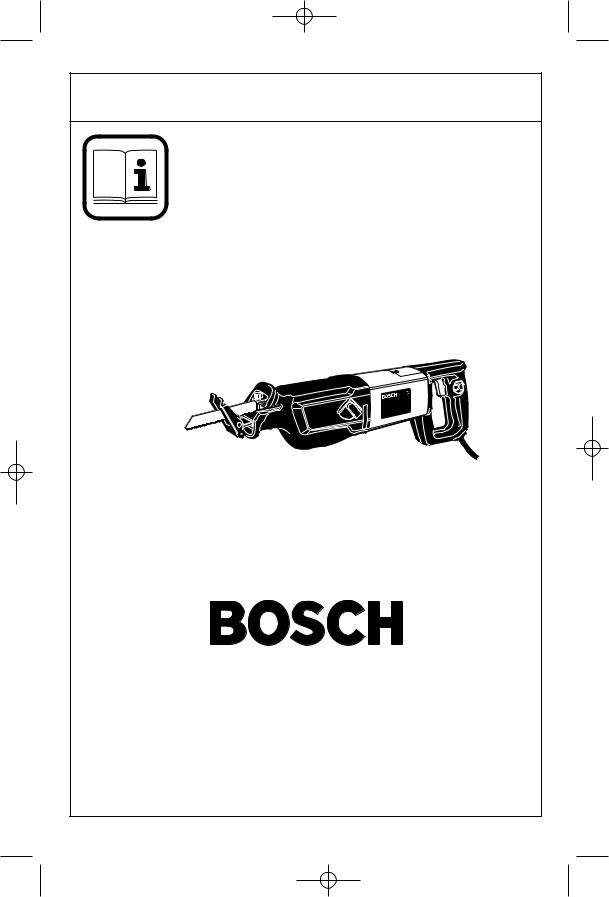
BM 2610910645 12/00 1/23/01 10:53 AM Page 1
IMPORTANT: |
IMPORTANT : |
IMPORTANTE: |
Read Before Using |
Lire avant usage |
Leer antes de usar |
Operating/Safety Instructions
Consignes de fonctionnement/sécurité
Instrucciones de funcionamiento y seguridad
1634VS
Consumer Information
Renseignement des consommateurs
Información para el consumidor
Toll Free Number: |
Appel gratuit : |
Número de teléfono gratuito: |
1-877-BOSCH99 (1-877-267-2499) http://www.boschtools.com. |
||
|
|
|
For English |
Parlez-vous français? |
¿Habla español? |
See page 2 |
Voir page 10 |
Ver página 18 |
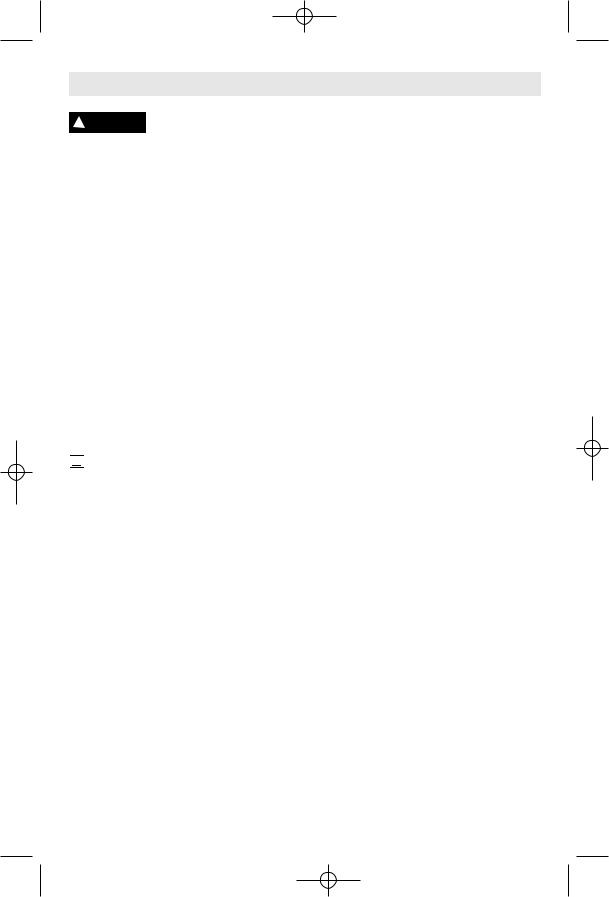
BM 2610910645 12/00 1/23/01 10:53 AM Page 2
Power Tool Safety Rules
! WARNING Read and understand all instructions. Failure to follow all instructions listed below, may result in electric shock, fire and/or serious personal injury.
SAVE THESE INSTRUCTIONS
Work Area
Keep your work area clean and well lit.
Cluttered benches and dark areas invite accidents.
Do not operate power tools in explosive atmospheres, such as in the presence of flammable liquids, gases, or dust. Power tools create sparks which may ignite the dust or fumes.
Keep by-standers, children, and visitors away while operating a power tool.
Distractions can cause you to lose control.
Electrical Safety
Double Insulated tools are equipped with a polarized plug (one blade is wider than the other.) This plug will fit in a polarized outlet only one way. If the plug does not fit fully in the outlet, reverse the plug. If it still does not fit, contact a qualified electrician to install a polarized outlet. Do not change the plug in any way. Double Insulation



 eliminates the need for the three wire grounded power cord and grounded power supply system. Before plugging in the tool, be certain the outlet voltage supplied is within the voltage marked on the nameplate. Do not use “AC only” rated tools with a DC power supply.
eliminates the need for the three wire grounded power cord and grounded power supply system. Before plugging in the tool, be certain the outlet voltage supplied is within the voltage marked on the nameplate. Do not use “AC only” rated tools with a DC power supply.
Avoid body contact with grounded surfaces such as pipes, radiators, ranges and refrigerators. There is an increased risk of electric shock if your body is grounded. If operating the power tool in damp locations is unavoidable, a Ground Fault Circuit Interrupter must be used to supply the power to your tool. Electrician’s rubber gloves and footwear will further enhance your personal safety.
Don't expose power tools to rain or wet conditions. Water entering a power tool will increase the risk of electric shock.
Do not abuse the cord. Never use the cord to carry the tools or pull the plug from an outlet. Keep cord away from heat, oil, sharp edges or moving parts. Replace damaged cords immediately. Damaged cords increase the risk of electric shock.
When operating a power tool outside, use an outdoor extension cord marked "W-A"
-2-
or "W." These cords are rated for outdoor use and reduce the risk of electric shock. Refer to “Recommended sizes of Extension Cords” in the Accessory section of this manual.
Personal Safety
Stay alert, watch what you are doing and use common sense when operating a power tool. Do not use tool while tired or under the influence of drugs, alcohol, or medication. A moment of inattention while operating power tools may result in serious personal injury.
Dress properly. Do not wear loose clothing or jewelry. Contain long hair. Keep your hair, clothing, and gloves away from moving parts. Loose clothes, jewelry, or long hair can be caught in moving parts. Keep handles dry, clean and free from oil and grease.
Avoid accidental starting. Be sure switch is “OFF” before plugging in. Carrying tools with your finger on the switch or plugging in tools that have the switch “ON” invites accidents.
Remove adjusting keys or wrenches before turning the tool “ON”. A wrench or a key that is left attached to a rotating part of the tool may result in personal injury.
Do not overreach. Keep proper footing and balance at all times. Proper footing and balance enables better control of the tool in unexpected situations.
Use safety equipment. Always wear eye protection. Dust mask, non-skid safety shoes, hard hat, or hearing protection must be used for appropriate conditions.
Tool Use and Care
Use clamps or other practical way to secure and support the workpiece to a stable platform. Holding the work by hand or against your body is unstable and may lead to loss of control.
Do not force tool. Use the correct tool for your application. The correct tool will do the job better and safer at the rate for which it is designed.

BM 2610910645 12/00 1/23/01 10:53 AM Page 3
Do not use tool if switch does not turn it “ON” or “OFF”. Any tool that cannot be controlled with the switch is dangerous and must be repaired.
Disconnect the plug from the power source before making any adjustments, changing accessories, or storing the tool.
Such preventive safety measures reduce the risk of starting the tool accidentally.
Store idle tools out of reach of children and other untrained persons. Tools are dangerous in the hands of untrained users.
Maintain tools with care. Keep cutting tools sharp and clean. Properly maintained tools, with sharp cutting edges are less likely to bind and are easier to control. Any alteration or modification is a misuse and may result in a dangerous condition.
Check for misalignment or binding of moving parts, breakage of parts, and any other condition that may affect the tools operation. If damaged, have the tool serviced before using. Many accidents are caused by poorly maintained tools. Develop
a periodic maintenance schedule for your tool.
Use only accessories that are recommended by the manufacturer for your model. Accessories that may be suitable for one tool, may become hazardous when used on another tool.
Service
Tool service must be performed only by qualified repair personnel. Service or maintenance performed by unqualified personnel could result in a risk of injury. For example: internal wires may be misplaced or pinched, safety guard return springs may be improperly mounted.
When servicing a tool, use only identical replacement parts. Follow instructions in the Maintenance section of this manual.
Use of unauthorized parts or failure to follow Maintenance Instructions may create a risk of electric shock or injury. Certain cleaning agents such as gasoline, carbon tetrachloride, ammonia, etc. may damage plastic parts.
Safety Rules for Reciprocating Saws
Hold tool by insulated gripping surfaces when performing an operation where the cutting tool may contact hidden wiring or its own cord. Contact with a "live" wire will make exposed metal parts of the tool "live" and shock the operator. Do not drill, fasten or break into existing walls or other blind areas where electrical wiring may exist. If this situation is unavoidable, disconnect all fuses or circuit breakers feeding this worksite.
Never leave the trigger locked "ON". Before plugging the tool in, check that the trigger lock is "OFF". Accidental start-ups could cause injury.
Be aware of the location and setting of the switch "Lock-ON" button. If the switch is locked "ON" during the use, be ready for emergency situations to switch it "OFF", by first pulling the trigger then immediately releasing it without pressing the "Lock-ON" button.
Keep hands away from cutting area. Do not reach under the material being cut.
The proximity of the blade to your hand is hidden from your sight.
Keep hands from between the gear housing and saw blade holder. The reciprocating blade holder can pinch your fingers.
Do not use dull or damaged blades. Bent blade can break easily or cause kickback.
Before starting to cut, turn tool "ON" and allow the blade to come to full speed.
Tool can chatter or vibrate if blade speed is too slow at beginning of cut and possibly kickback.
Always wear safety goggles or eye protection when using this tool. Use a dust mask or respirator for applications which generate dust.
Secure material before cutting. Never hold it in your hand or across legs. Small
-3-
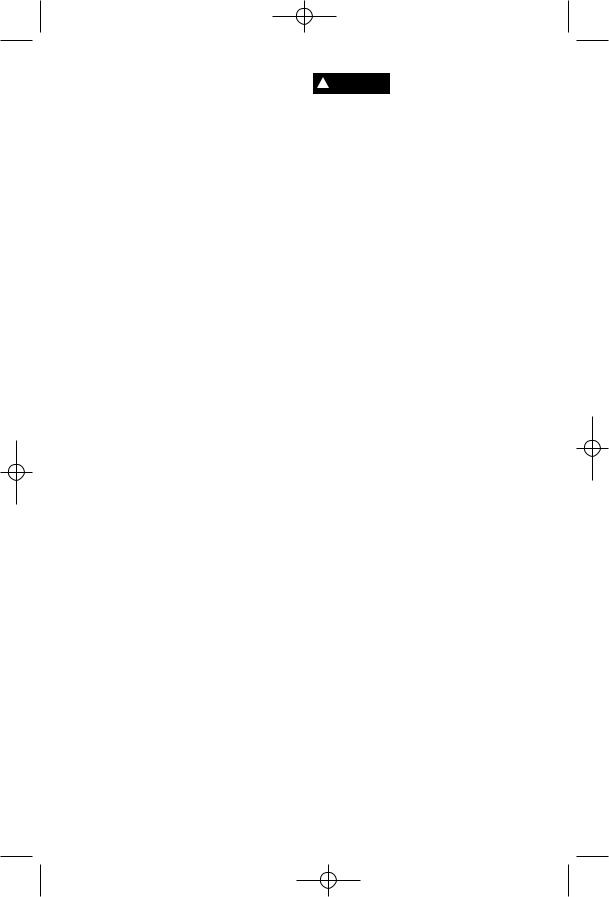
BM 2610910645 12/00 1/23/01 10:53 AM Page 4
or thin material may flex or vibrate with the blade, causing loss of control.
Make certain all adjusting screws and the blade holder are tight before making a cut. Loose adjusting screws and holders can cause the tool or blade to slip and loss of control may result.
When removing the blade from the tool avoid contact with skin and use proper protective gloves when grasping the blade or accessory. Accessories may be hot after prolonged use.
-4-
Some dust created by power sanding, sawing, grinding, drilling, and other construction
activities contains chemicals known to cause cancer, birth defects or other reproductive harm. Some examples of these chemicals are:
•Lead from lead-based paints,
•Crystalline silica from bricks and cement and other masonry products, and
•Arsenic and chromium from chemicallytreated lumber.
Your risk from these exposures varies, depending on how often you do this type of work. To reduce your exposure to these chemicals: work in a well ventilated area, and work with approved safety equipment, such as those dust masks that are specially designed to filter out microscopic particles.
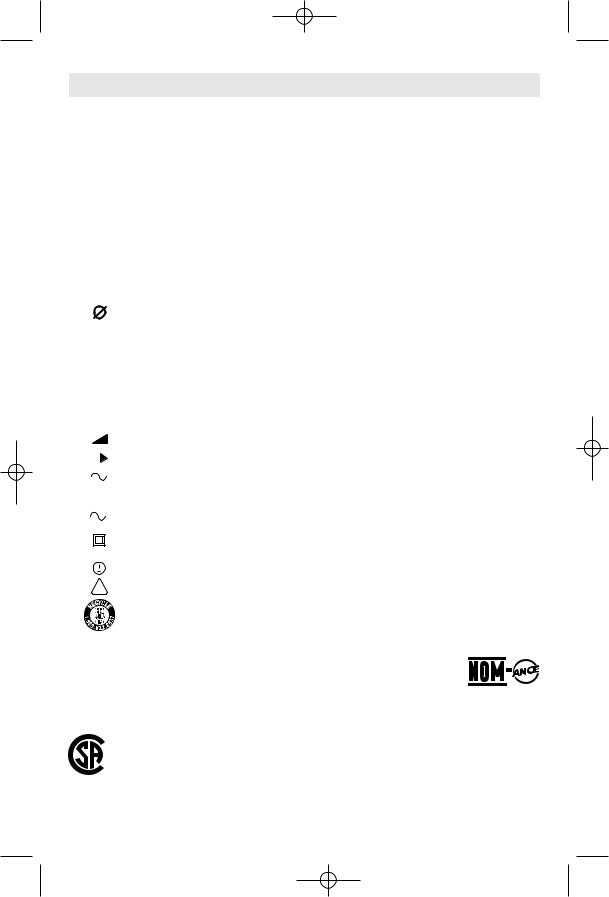
BM 2610910645 12/00 1/23/01 10:53 AM Page 5
Symbols
IMPORTANT: Some of the following symbols may be used on your tool. Please study them and learn their meaning. Proper interpretation of these symbols will allow you to operate the tool better and safer.
Symbol |
Name |
Designation/Explanation |
||||||||
|
|
|
|
|
|
|
|
|
|
|
|
|
|
|
V |
Volts |
Voltage (potential) |
||||
|
|
|
|
A |
Amperes |
Current |
||||
|
|
|
|
|
|
|
|
|
|
|
|
|
Hz |
Hertz |
Frequency (cycles per second) |
||||||
|
|
|
W |
Watt |
Power |
|||||
|
|
kg |
Kilograms |
Weight |
||||||
|
|
|
|
|
|
|
|
|
|
|
|
min |
Minutes |
Time |
|||||||
|
|
|
|
s |
Seconds |
Time |
||||
|
|
|
|
|
|
|
|
|
Diameter |
Size of drill bits, grinding wheels, etc. |
|
|
|
|
|
|
|
|
|
|
|
|
|
|
n0 |
No load speed |
Rotational speed, at no load |
|||||
.../min |
Revolutions or reciprocation per minute |
Revolutions, strokes, surface speed, |
||||||||
|
|
|
|
|
|
|
|
|
|
orbits etc. per minute |
0 |
|
|
|
Off position |
Zero speed, zero torque... |
|||||
|
|
|
|
|
|
|
|
|
|
|
1, 2, 3, ... |
Selector settings |
Speed, torque or position settings. |
||||||||
I, II, III, |
|
Higher number means greater speed |
||||||||
|
|
|
|
|
|
|
|
|
|
|
0 |
|
|
|
|
|
|
Infinitely variable selector with off |
Speed is increasing from 0 setting |
||
|
|
|
|
|
|
|
|
|
Arrow |
Action in the direction of arrow |
|
|
|
|
|
|
|
|
|
||
|
|
|
|
|
|
|
|
|
Alternating current |
Type or a characteristic of current |
|
|
|
|
|
|
|
|
|
|
|
|
|
|
|
|
|
|
|
|
Direct current |
Type or a characteristic of current |
|
|
|
|
|
|
|
|
|
||
|
|
|
|
|
|
|
|
|
Alternating or direct current |
Type or a characteristic of current |
|
|
|
|
|
|
|
|
|
||
|
|
|
|
|
|
|
|
|
Class II construction |
Designates Double Insulated |
|
|
|
|
|
|
|
|
|
||
|
|
|
|
|
|
|
|
|
|
Construction tools. |
|
|
|
|
|
|
|
|
|
|
|
|
|
|
|
|
|
|
|
|
|
|
|
|
|
|
|
|
|
|
|
Earthing terminal |
Grounding terminal |
|
|
|
|
|
|
|
|
|
||
|
|
|
|
|
|
|
|
|
Warning symbol |
Alerts user to warning messages |
|
|
|
|
|
|
|
|
|
||
|
|
|
|
|
|
|
|
|
||
|
|
|
|
|
|
|
|
|
Ni-Cad RBRC seal |
Designates Ni-Cad battery recycling |
|
|
|
|
|
|
|
|
|
|
program |
|
|
|
|
|
|
|
|
|
|
|
This symbol designates that this tool is listed by Underwriters Laboratories.
This symbol designates that this tool is listed by the Canadian Standards Association.
This symbol designates that this tool is listed to Canadian Standards by Underwriters Laboratories.
This symbol designates that this tool is listed by Underwriters Laboratories, and listed to Canadian Standards by Underwriters Laboratories.
This symbol designates that
this tool complies to NOM Mexican Standards.
-5-
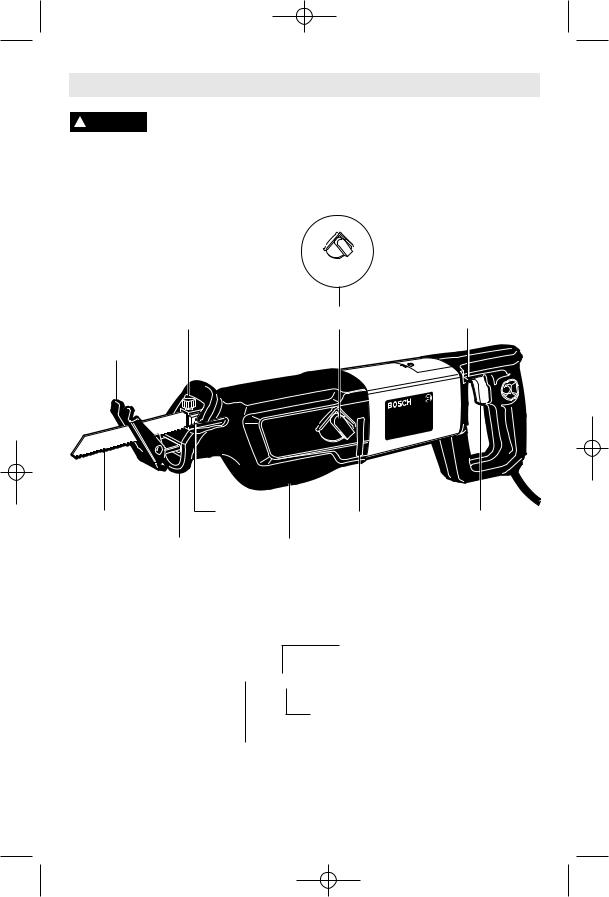
BM 2610910645 12/00 1/23/01 10:53 AM Page 6
Functional Description and Specifications
Disconnect the plug from the power source before making any assembly, adjustments or changing accessories. Such preventive safety
measures reduce the risk of starting the tool accidentally.
Reciprocating Saw
BLADE RELEASE |
BLADE ORBIT |
2-SPEED SELECTOR |
KNOB |
SELECTOR |
LEVER |
FOOTPLATE
|
SET |
AIR VENT |
|
SAWBLADE |
SCREW |
VARIABLE SPEED |
|
|
|
|
CONTROLLED |
|
4 |
BOOT |
TRIGGER |
|
|
FOOTPLATE
RELEASE BUTTON
LOCKWASHER
(OPTIONAL ACCESSORIES)
SCREW - BLADE CLAMPING (OPTIONAL ACCESSORIES)
STANDARD BLADE CLAMP (OPTIONAL ACCESSORIES)
NOTE: For tool specifications refer to the nameplate on your tool.
-6-
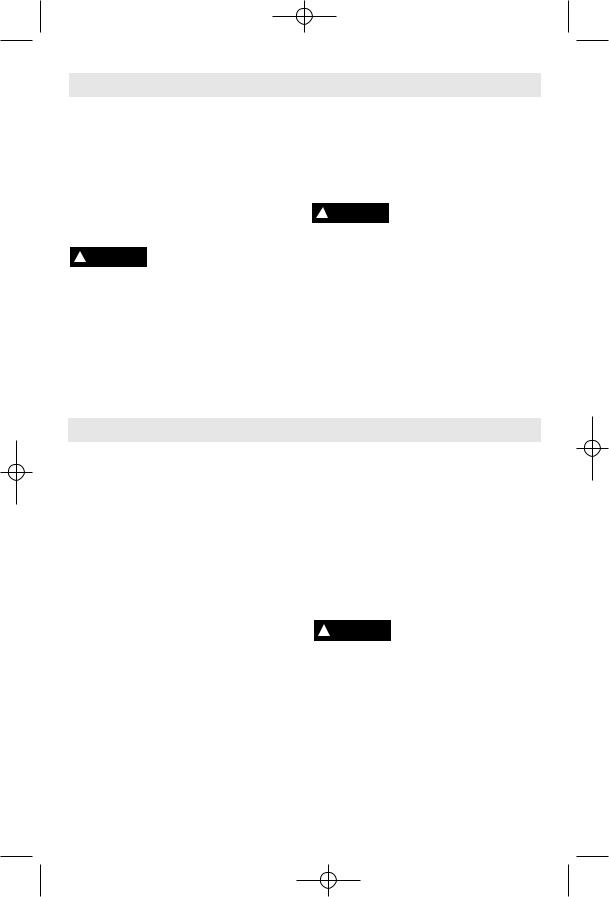
BM 2610910645 12/00 1/23/01 10:53 AM Page 7
Assembly
Preparing the Saw
BLADE SELECTION
No one blade can be efficient on all cutting jobs. Different materials require specially designed blades. Since your reciprocating saw can cut so many materials, many types of BOSCH blades are available. Be sure to use the proper blade to insure proper cutting performance.
INSTALLING A BLADE
! WARNING Unplug tool from power source before changing
blade or making any adjustments.
The CLIC™ wrenchless blade change clamp can only be operated when the plunger is fully extended. To fully extend plunger, while blade is mounted, hook the blade teeth on a scrap workpiece or hidden area and pull the tool backwards. If no blade is in the plunger, gently press trigger switch to position plunger to it's fully extended position.
Simply rotate the blade release knob clockwise to open the clamp; insert the blade until it stops and release the knob. The spring loaded mechanism will lock the clamp against the blade. Push in and pull out on the blade to be sure it is held securely. The blade may be inserted with the teeth facing up or down.
! WARNING Some specialty blades (such as 7º kant) cannot be used in
the inverted position. Always check to be sure blade does not contact footplate in any stroke position or footplate position.
NOTE: If you require a standard blade clamp for any reason (extra thick blades, very thin blades, etc.) a packet is available for the saw which contains a clamp, hex key, screw and lockwasher. To use the standard clamp, remove the quick change clamp assembly by unscrewing the set screw which holds it onto the draw bar. Then assemble the standard clamp with the screw and lockwasher provided.
Operating Instructions
VARIABLE SPEED CONTROLLED
TRIGGER SWITCH
Your tool is equipped with a variable speed controlled trigger switch. The tool can be turned "ON" or "OFF" by squeezing or releasing the trigger. The blade plunger stroke rate can be adjusted from the minimum to maximum nameplate stroke rate by the pressure you apply to the trigger. Apply more pressure to increase the speed and release pressure to decrease speed.
2-SPEED SELECTOR LEVER
In addition to the variable speed trigger switch, the saw is also equipped with a two speed switch which is controlled with a selector lever .
When the selector lever is pointed to the left, the saw will operate up to its maximum speed of 2700 SPM (strokes per minute). This speed setting is generally used when cutting softer materials such as wood.
When the selector lever is pointed to the right, the saw will operate up to the lower speed of 1900 SPM. This speed setting is generally used when cutting harder materials such as steel.
FOOTPLATE ADJUSTMENT
The footplate pivots in order to keep a relatively large surface in contact with the work. It can be locked into 1 of 3 positions to optimize blade life and/or to limit blade protrusion beyond the end of the footplate when cutting into large diameter pipe or into walls. To adjust the footplate position, simply push the area 4 indicated by the symbol on the boot and move the footplate into the desired position. The locking mechanism is spring loaded to lock into one of the 3 notches on the footplate bracket.
! WARNING |
Pushing the footplate release |
|
button while sawing may |
cause the foot to release from the desired settings.
ORBIT SELECTOR
To obtain the best cutting advance in various types of materials, your saw has a blade orbit selector to adjust the swing of the saw blade. When cutting into wood and plastic, as well as other soft materials, a larger swing of the blade is desired. There are two orbit selector positions (see figure page 6). The non-orbit position (metal), move the orbit selector lever toward the straight cut symbol and for a full
-7-
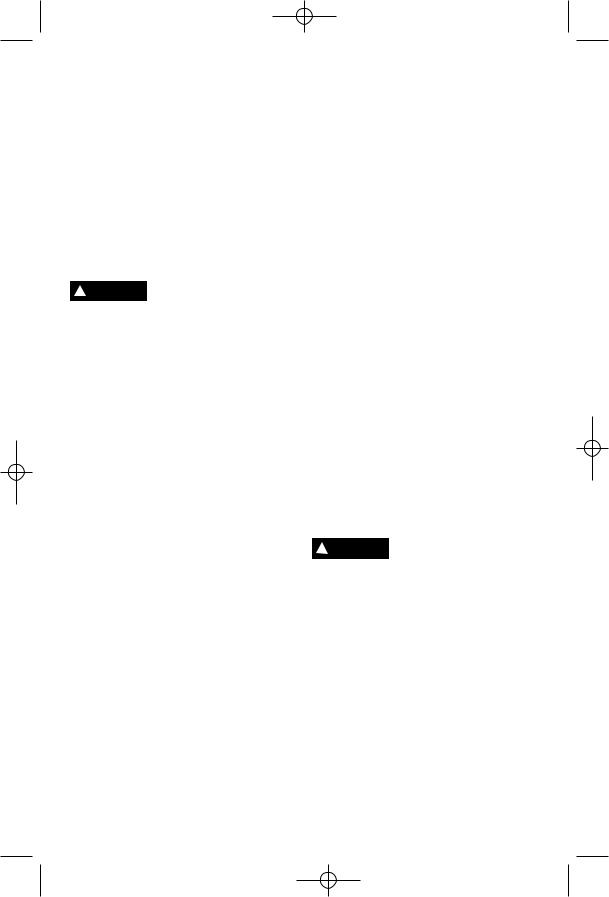
BM 2610910645 12/00 1/23/01 10:53 AM Page 8
orbit (wood), move the selector lever toward the orbit cut symbol.
The non-orbit gives the best cutting advance and extends blade life when cutting steel and similar hard materials which have more resistance to cut. For materials that have less resistance to cut, the orbit position can be selected for the best cutting advance. The orbit selector can be adjusted with the motor switched on or at a standstill.
USING THE SAW
1.Securely clamp the work.
2.Mark the line of cut and grasp the tool with one hand on the handle and the other placed on the front housing.
! WARNING Always operate the saw with the insulated boot on the
front housing.
3.Keep the saw footplate firmly against the work to minimize counter-force (jumping) and vibration.
4.Squeeze the trigger to start the tool. Let the saw reach full speed before starting the cut. Guide the saw so that the blade will move along the marked line.
Sawing Tips
3.When cutting metal, apply a lubricant for easier, smoother, faster cutting and longer blade life.
4.For non-ferrous metals, aluminum, bronze or brass, use a stick wax on the blade. For ferrous metals, iron and steel, use machine or cutting oil along the surface to be cut.
5.When cutting thin metal, “sandwich” the material between two pieces of scrap wood. Clamp or put in a bench vise. One piece of lumber on top of the metal can be used with adequate clamping. Place your cut lines or design on the wood.
POCKET CUTS
The reciprocating saw can be used to make plunge cuts into material, if it is not too hard (for example, wood or light building materials for walls), without a starting hole. In harder materials, such as metal, a hole large enough to take the saw blade should be drilled beforehand.
1.Mark the line to be cut clearly on the work.
2.Set the tool with one edge of the footplate firmly against the material.
3.Place the tip of the blade (not running) on the line to be cut.
Following a few simple tips will reduce the wear on both the tool and the operator.
1.The blade cuts on the draw or back stroke. On fine work, such as paneling, fiber glass, etc., place the good side of workpiece facing down.
2.Use the correct saw blade for the material being cut and keep extra blades on hand to use when others become dull. Replace cracked or bent blades immediately.
4. Tilt the saw so that the blade clears the work.
5. Squeeze the trigger switch and carefully engage the moving saw blade into the material.
6. After the blade penetrates through the work, continue sawing along the marked outline.
The use of any accessories not specified in this manual
may create a hazard.
-8-
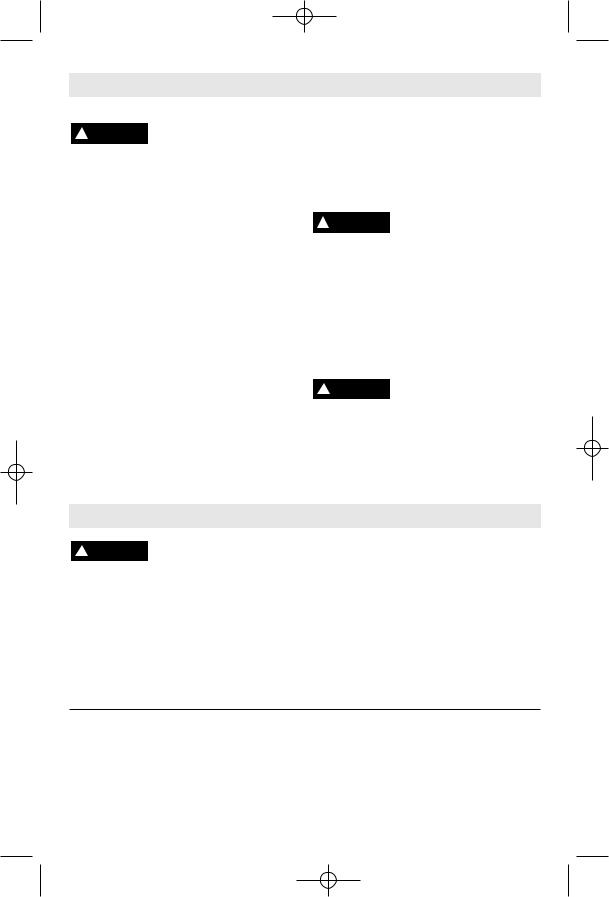
BM 2610910645 12/00 1/23/01 10:53 AM Page 9
Maintenance
Service
Preventive maintenance performed by unauthorized personnel may result in misplacing of
internal wires and components which could cause serious hazard. We recommend that all tool service be performed by a Bosch Factory Service Center or Authorized Bosch Service Station.
TOOL LUBRICATION
Your Bosch tool has been properly lubricated and is ready to use. It is recommended that tools with gears be regreased with a special gear lubricant at every brush change.
CARBON BRUSHES
The brushes and commutator in your tool have been engineered for many hours of dependable service. To maintain peak efficiency of the motor, we recommend every two to six months the brushes be examined. Only genuine Bosch replacement brushes specially designed for your tool should be used.
BEARINGS
After about 300-400 hours of operation, or at every second brush change, the bearings
should be replaced at Bosch Factory Service Center or Authorized Bosch Service Station. Bearings which become noisy (due to heavy load or very abrasive material cutting) should be replaced at once to avoid overheating or motor failure.
Cleaning
To avoid accidents always disconnect the tool from the power supply before cleaning or
performing any maintenance. The tool may be cleaned most effectively with compressed dry air. Always wear safety goggles when cleaning tools with compressed air.
Ventilation openings and switch levers must be kept clean and free of foreign matter. Do not attempt to clean by inserting pointed objects through openings.
! CAUTION Certain cleaning agents and solvents damage
plastic parts. Some of these are: gasoline, carbon tetrachloride, chlorinated cleaning solvents, ammonia and household detergents that contain ammonia.
Accessories
If an extension cord is necessary, a cord with adequate size conductors that is capable
of carrying the current necessary for your tool must be used. This will prevent excessive voltage drop, loss of power or overheating. Grounded tools must use 3- wire extension cords that have 3-prong plugs and receptacles.
NOTE: The smaller the gauge number, the heavier the cord.
RECOMMENDED SIZES OF EXTENSION CORDS 120 VOLT ALTERNATING CURRENT TOOLS
Tool’s |
Cord Size in A.W.G. |
Wire Sizes in mm2 |
|||||||
|
|
|
|
|
|
|
|
||
Ampere |
|
|
|
|
|
|
|
|
|
Cord Length in Feet |
Cord Length in Meters |
||||||||
Rating |
|||||||||
|
25 |
50 |
100 |
150 |
15 |
30 |
60 |
120 |
|
3-6 |
|
|
|
|
|
|
|
|
|
18 |
16 |
16 |
14 |
.75 |
.75 |
1.5 |
2.5 |
||
6-8 |
18 |
16 |
14 |
12 |
.75 |
1.0 |
2.5 |
4.0 |
|
8-10 |
18 |
16 |
14 |
12 |
.75 |
1.0 |
2.5 |
4.0 |
|
10-12 |
16 |
16 |
14 |
12 |
1.0 |
2.5 |
4.0 |
— |
|
12-16 |
14 |
12 |
— |
— |
— |
— |
— |
— |
|
|
|
|
|
|
|
|
|
|
|
* |
Carrying case |
(*= standard equipment) |
* |
Blades |
(**= optional accessories) |
|
|
** Standard blade clamp
-9-
